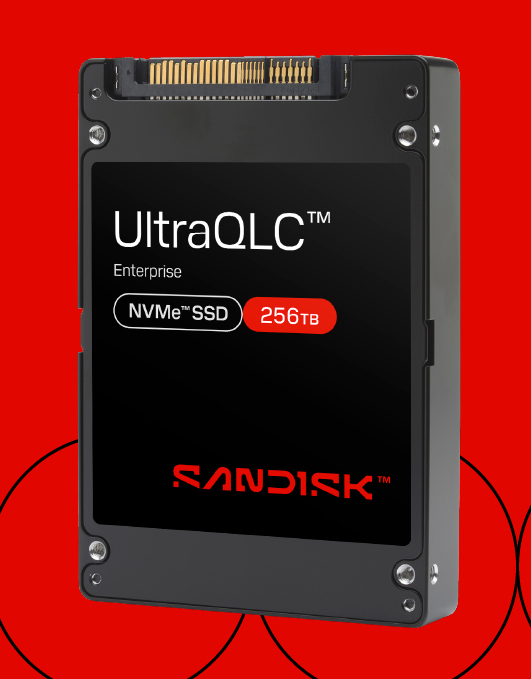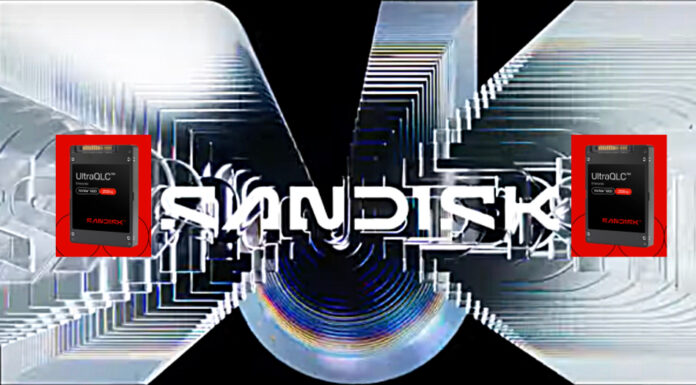Sandisk has announced a 256 TB SSD at FMS 2025 that will ship in the first half of 2026.
The Sandisk UltraQLC SN670 drive comes in 256 TB and 128 TB capacities, and uses BiCS 218-layer 3D NAND with its CBA (CMOS directly Bonded to Array) 2 Tb die design, and a PCIe gen5 NVMe interface. It is intended for use in AI-driven, data-intensive workloads like data ingest, preparation, and AI data lakes. It uses the same NAND as fab partner Kioxia and, we’re told, beats its 245.76 TB LC9 product‘s capacity by more than 10 TB.

Khurram Ismail, Sandisk chief product officer, stated: “As we move into the next phase of the AI era, flash storage is becoming a critical enabler of intelligent, high-performance workloads.”
Sandisk says the UltraQLC drive has a customized controller and advanced optimizations, but not a fast single-level cell (SLC) cache. There is a Direct Write QLC feature with power-loss safe writes on the first pass. This typically means slower performance than equivalent drives using an SLC cache, unless the controller does something clever to speed things up.
It has Dynamic Frequency Scaling with up to 10 percent better projected performance for a given power level. A Data Retention (DR) profile forecast reduces DR recycles by up to 33 percent, “improving drive reliability, resilience and continuous access to data while decreasing power consumption.”
Mike James, senior director of Enterprise SSD Systems Architecture at Sandisk, said in a blog: “When you’re getting into higher and higher capacities of SSDs, interesting challenges emerge. One example is the challenge of data recycling on NAND at this scale. You can’t overwrite 128 terabytes every few days – it’s not effective or efficient. So, we’re constantly finding new ways to truncate how much needs to be recycled and inventing novel methods to reduce the impact of recycling in the background.”
Sandisk says the SN670 has “lower latency, higher bandwidth, and greater reliability, and delivers the performance needed for today’s most demanding AI workloads.” But there are no performance numbers, such as random read/write IOPS and sequential read/write bandwidth available, nor endurance stats to back this up.

The SN670 will be available in a U.2 (2.5-inch) form factor in the first half of 2026 with additional form factors available later in the year. Sandisk is preparing to put the first 128TB drives into customers’ hands for testing in a few weeks. The blog referenced above says the UltraQLC roadmap extends out to a 1 PB SSD.
Comment
If the SN670 is deliverable by April 2026, that means it has eight months of development ahead of it, and that could be why there is no performance and endurance data – the drive and its controller are simply not yet ready for final testing.
For clues about performance, we can look at earlier Sandisk information. Western Digital, in pre-Sandisk spinoff days, mentioned a possible 128 TB version of its Ultrastar DC SN655 SSD at FMS 2024. This would have been a PCIe Gen 4 QLC 218-layer drive, unlike the 3.84 TB to 61.44 TB SN655s, which used TLC 112-layer flash and the PCIe Gen 4 interface.
A few months later, Sandisk presented the UltraQLC SN670 at an Investor Day in February, saying it was a PCIe Gen 5 drive. The SN670 was compared to a “leading Gen 5 128 TB QLC SSD,” and had over 68 percent faster random read speed, more than 55 percent faster random write speed, over 7 percent better sequential read speed, and more than 27 percent better sequential write speed. It was then scheduled to ship in the third quarter of 2025 with 128 TB and 64 TB capacities – 122.88 TB and 61.44 TB usable. That date has slipped by two or more quarters and the maximum capacity has since doubled, which would mean more testing. (Detailed performance data is not present in Sandisk’s SN670 announcement, though we did ask for it.)
Three months later, in May, Sandisk CEO David Goeckeler talked about new 2 Tb QLC NAND chips to be used in coming 128 TB and 256 TB drives with PCIe Gen 5 and 6 interconnectivity and a new Stargate SSD controller.
On this basis, the PCIe Gen5 SN670 will have much higher performance than the PCIe Gen 4-using SN655, and also the Solidigm and Phison high-capacity PCIe Gen 5 SSDs.








